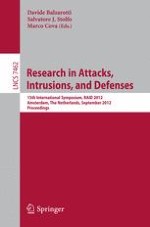2012 | OriginalPaper | Buchkapitel
Malware Detection System by Payload Analysis of Network Traffic (Poster Abstract)
verfasst von : Luis Javier García Villalba, Jaime Daniel Mejía Castro, Ana Lucila Sandoval Orozco, Javier Martínez Puentes
Erschienen in: Research in Attacks, Intrusions, and Defenses
Verlag: Springer Berlin Heidelberg
Aktivieren Sie unsere intelligente Suche, um passende Fachinhalte oder Patente zu finden.
Wählen Sie Textabschnitte aus um mit Künstlicher Intelligenz passenden Patente zu finden. powered by
Markieren Sie Textabschnitte, um KI-gestützt weitere passende Inhalte zu finden. powered by
NIDS based on Payload Analysis detect the malicious code by analyzing the payload of packets flowing through the network. Typically consist of a training phase and another one of detection. The training phase is done with clean traffic so that it represents statistically the usual traffic of the system. Thus, a pattern of such traffic is established. On the other hand, during the detection, traffic analysis is modeled and compared these patterns to determine if it can be classified as dangerous. Then, various proposals that make analysis of the payload to detect malicious code are explicated. In general, all are variants of PAYL [1], one of the first proposals that used this technique successfully. PAYL system classifies traffic based on three characteristics: the port, packet size and flow direction (input or output). Using these three parameters, payloads are classified creating a series of patterns to define what would be normal behavior within each class. Poseidon [2] was developed to correct the errors that arise in building models in PAYL when clustering about the size of packets is applied. The combination of multiple classifiers of a class, also based on PAYL, was developed to eliminate the original system’s vulnerability in the face of mimicry attacks. PCNAD [3] appears to correct the defect PAYL that could not process large packets on fast networks with enough speed. Anagram is another evolution of PAYL, developed by the same authors to correct the deficiencies that had the original system. As in the PAYL, the system is based on n-grams to process the packets and create patterns of behavior. However, it employed Bloom Filters to divide the packets in n-grams of sizes larger than one without the cost in space and system performance will be injured.
